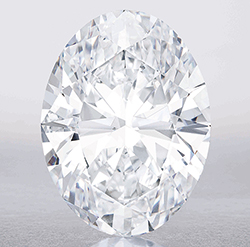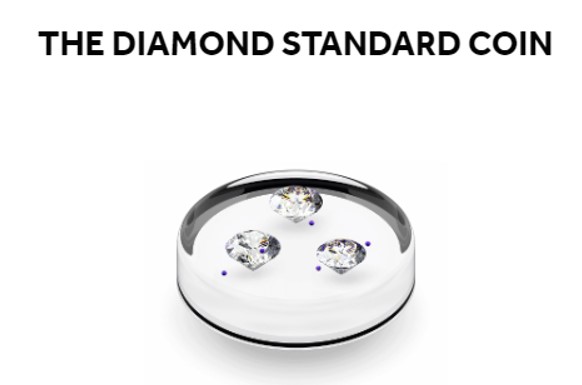Alt Investments
Tech Brings Diamonds Towards Fully Commoditised Market

Diamonds are famously unique, which in the past has limited their appeal as commodities. But that may be starting to change as new technology takes hold, a practitioner in the space argues.
Within the
alternative asset class kaleidoscope, an important niche is
the diamond market, worth more than $82 billion in 2017, based on
latest available data (source: statista). The diamond jewellery
market is of course very old – people have bought, sold, dug and
fought over these gems for centuries. Novels have been written
and movies have made about them, and they feature in
songs.
One challenge, however, is that diamonds aren’t “fungible” as a
commodity in the way gold is. Each diamond is different, in terms
of “cut” (the quality that unleashes its light); clarity, colour
and carat (weight). Gold, by contrast, can be divided into
equal-sized lumps; it has a standard weight and consistency. This
explains why gold remains (to the frustration of some modern
economists) an important component of today’s monetary
order.
But could there be ways to standardise a market for diamonds?
Well, the accelerating world of cryptocurrencies and associated
tech such as blockchain and “tokenisation” may hold the key. A
recently-established firm, Diamond Standard,
is building a diamond commodity that it predicts will
revolutionise the market. The business, based in the US and
Bermuda and a founder member of the Diamond Standard Exchange, is
applying to be regulated by the Bermuda Monetary Authority. This
news service recently spoke to the firm’s CEO and founder, Cormac
Kinney, about this venture.
“For family offices [and other wealthy individuals] it is a new
investment asset; it is a new type of diversification and new
store of wealth,” Kinney said.
How does the Diamond Standard work? The firm’s process produces
“coins” and “bars” composed in such a way that they reflect the
proportions of diamonds’ defining qualities (carat, cut, etc)
across the entire diamond market as found in the earth. This
creates a standardised measure of such qualities – allowing a
fungible commodity to develop, which can then be tokenised via
blockchain distributed ledger technology. The fungible sets of
diamonds are sealed in transparent resin – to create the Diamond
Standard Coin or Diamond Standard Bar - containing a military
grade wireless encryption chip. The commodity is always delivered
to the buyer or their custodian and can be easily verified. The
diamonds also can be removed and used, though not as a commodity.
Here is a picture of such a "coin" from Diamond Standard's
website:

Custodians store the commodity in smart cabinets, which audit
them constantly, and enable owners to transact them remotely
using the “Bitcarbon” token. The owner alone has the digital key.
For every transaction, the encryption chip is challenged by the
blockchain in a process called "proof-of-asset”. When the
commodity is held by the owner it can be authenticated and sold
using a smartphone, anywhere in the world.
There have been past attempts to build such a commoditised way of
trading diamonds, but they typically foundered because of the
fungibility issue. But the arrival of blockchain technology,
which has been in the works for more than five years, has
helped change the game, Kinney said.
Big market
Besides the jewellery market, there is a smaller but important
segment for industrial diamonds (used to cut metal, for example).
The global industrial diamond market size was estimated at $1.79
billion in 2018, according to Grand View Research.
There is a good deal of resistance to the idea that diamonds
could be a major source of investment. The Investopedia website
(an invaluable resource for journalists and investors) has this
comment: “Diamonds as gemstones are generally considered a poor
investment vehicle, mainly due to the illiquidity of the market,
a lack of price transparency, high transaction fees and high risk
related to quality assurance.” (It suggests that investors should
buy funds that track the gemstone sector.)
This is a fragmented market with no central point of data for
prices and investment returns. One of the most prominent
information sources is the Rapaport series of reports on diamond
prices (available by subscription). Rapaport churns out price
indices, such as RapNet Diamond Index (RAPI™). Auction houses
such as Sotheby’s and Christie’s will produce auction results – a
problem, however, is being able to track these over time and
compare the final agreed price paid and what the initial offer
might be.
Kinney and his colleagues hope that their venture will
drastically clarify this area. The scale of the market is vast –
and not readily appreciated by non-experts. “We buy diamonds
every day with a transparently based and regulated exchange. We
make a cash bid for 16 million different types of diamond every
day,” Kinney said.
The Diamond Standard Exchange, which is owned and controlled by
its members (brokers, dealers), has offered membership to
organisations such as Richemont, Tiffanys, etc. “All these
companies are joining together as members of a regulated exchange
where there’s now a market maker,” Kinney said.
The Diamond Standard only uses natural diamonds, not man-made
ones. Also, by only buying from members of the exchange, it
eliminates the threat of conflict diamonds entering the system,
he said.
“The exchange is bringing tremendous efficiency to the
supply/demand chain,” he said. Adding that the greater price
transparency and efficiency is good for diamond miners and
cutters, and good for the jewellery buyers and certain specialist
areas.